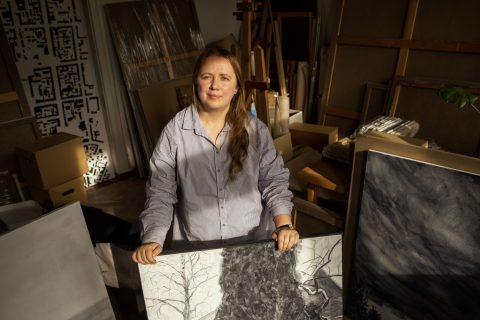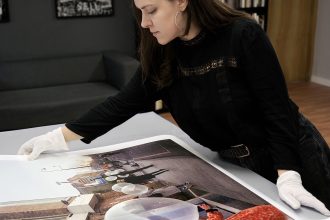The other time, when we were saying goodbye to each other with Elena Balsiukaitė-Brazdžiūnienė, we wished each other to drink our fill of September evening’s radiance – intoxicating and a little desperate. According to Elena, “As if the sun would be throwing its last money on the table.” Her unique ability to enjoy the ambient light in a painterly way, but also to aptly name it, inspired me to interview the artist.
Today everything is different. The sky is pale, and the wind makes you crouch. When I visit the artist’s studio in Šančiai, I am welcomed by Virginia Woolf, coquettishly holding a cigarette in her blue-gloved hand.
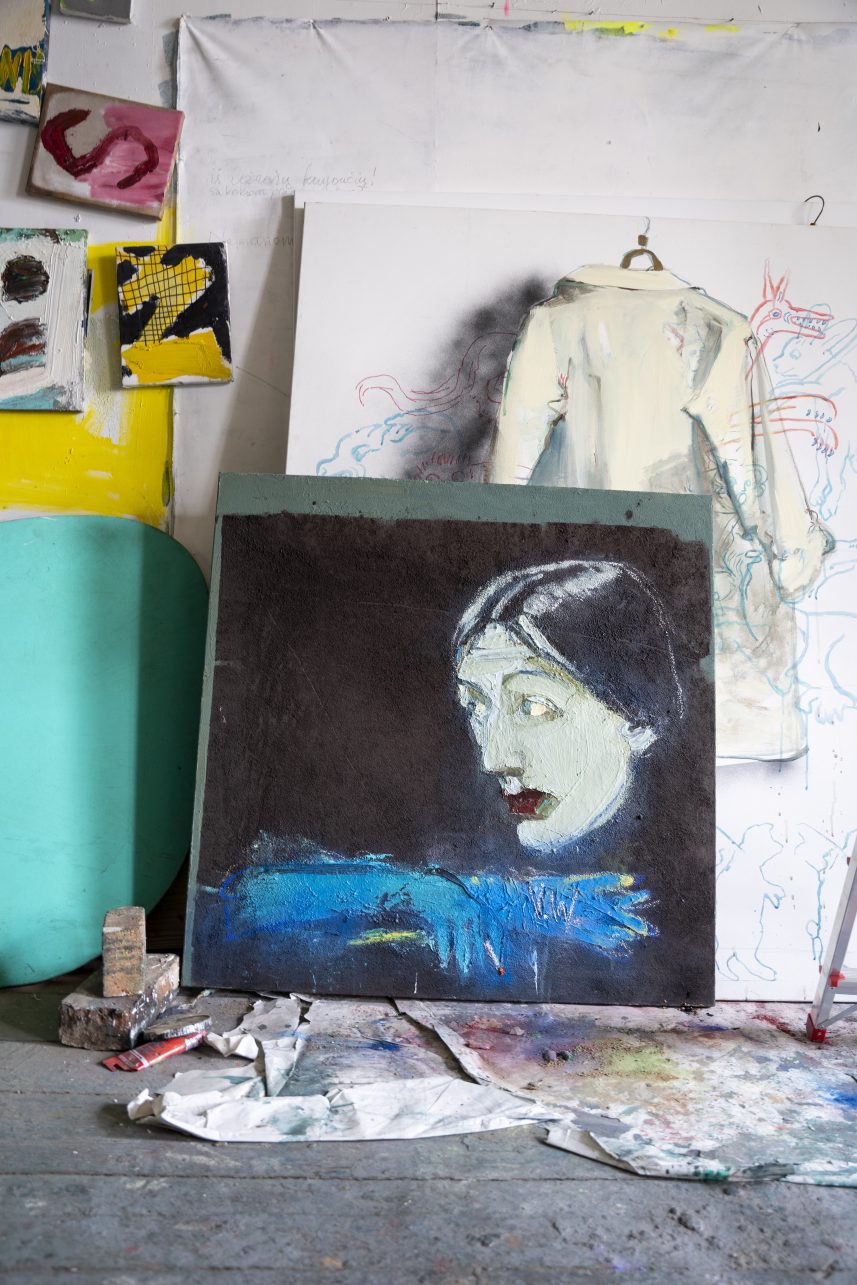
“Did you recognize her?” Elena asks. She nods to me and continues, “I just had to paint her. It’s essential to me. She’s a wonderful writer. Those blue gloves and their colour are the same as suffragist socks. I don’t know if she smoked simple cigarettes or the elegant ones with the cigarette holder. This is about freedom. Anyway, what is it that you wanted from me, dear?”
I reminded her that we were planning to talk about colours, but I sensed that I didn’t want to make the topic I brought with me more important than all that Sunday afternoon could offer spontaneously. Especially if you spend it in the painter’s creative sanctuary.
“Oh, I couldn’t get in here for a while, the lock got stuck. Someone decided not to let me in. Here is all my chaos. But maybe I like it more controlled. I also miss the order.”
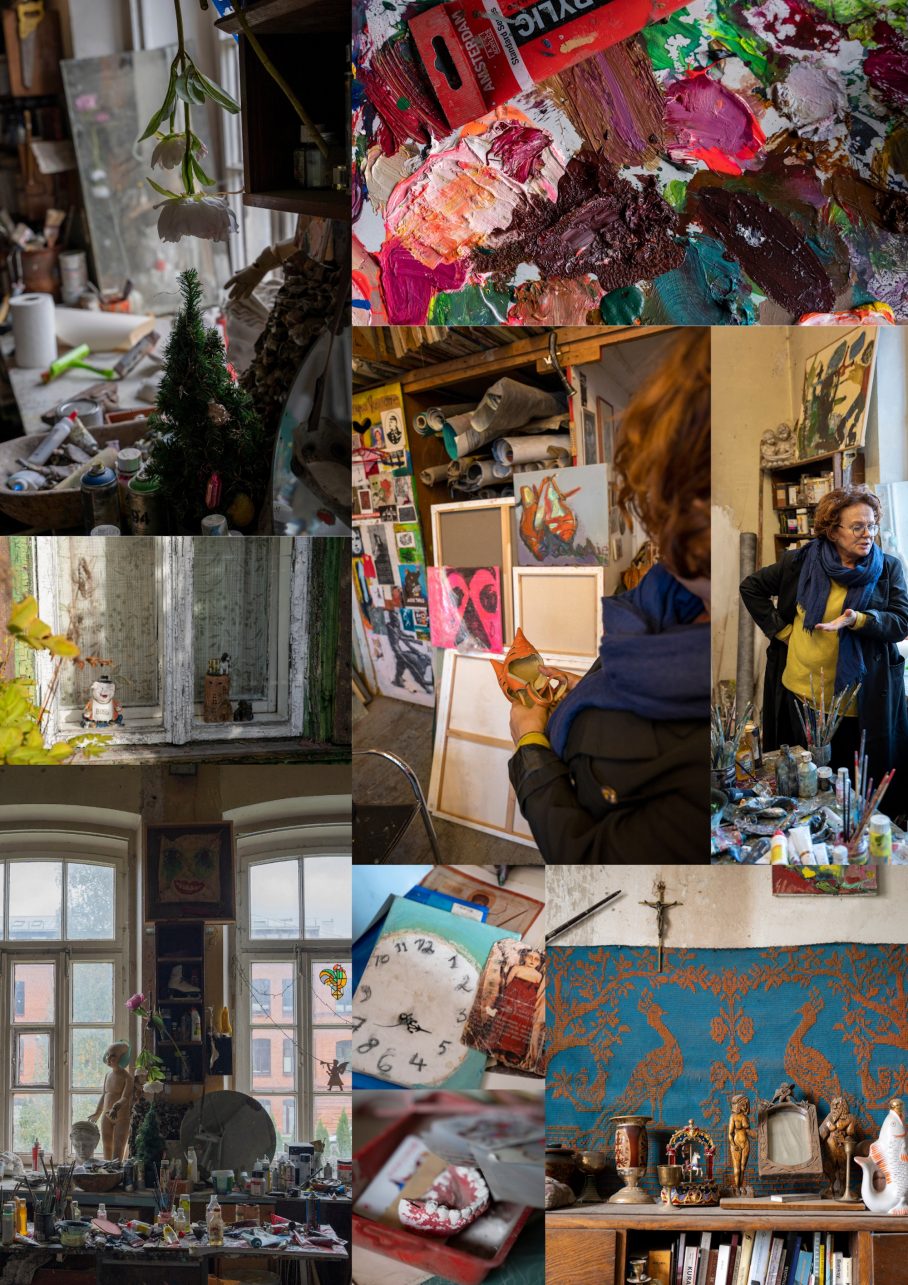
After looking around I can see what she means. Various objects, trinkets, and artifacts are lined up or accidentally dropped into intertwining still lifes. There are plenty of stories, characters, and scenes. All timelines are possible, including alternative ones. Elena is the director of this universe, but at the same time, this world is her inexhaustible source of inspiration.
I see her former student’s childish drawings on the table. “There was so much courage in the gesture of that hand, how precisely every colour patch was incorporated,” Elena takes one drawing. “She was a very talented girl. Imagine, now she is a singer at the musical theatre. I told her I had her drawings. I just keep them close at hand – they bring so much joy.”
There are at least two pairs of fancy ladies’ shoes in the studio. The origin of both may not be important, they remain anonymous, but their refined shapes or almost fluorescent colours arouse the imagination. It seems that they are real objects of the painter’s fetish and perfect models for painting.

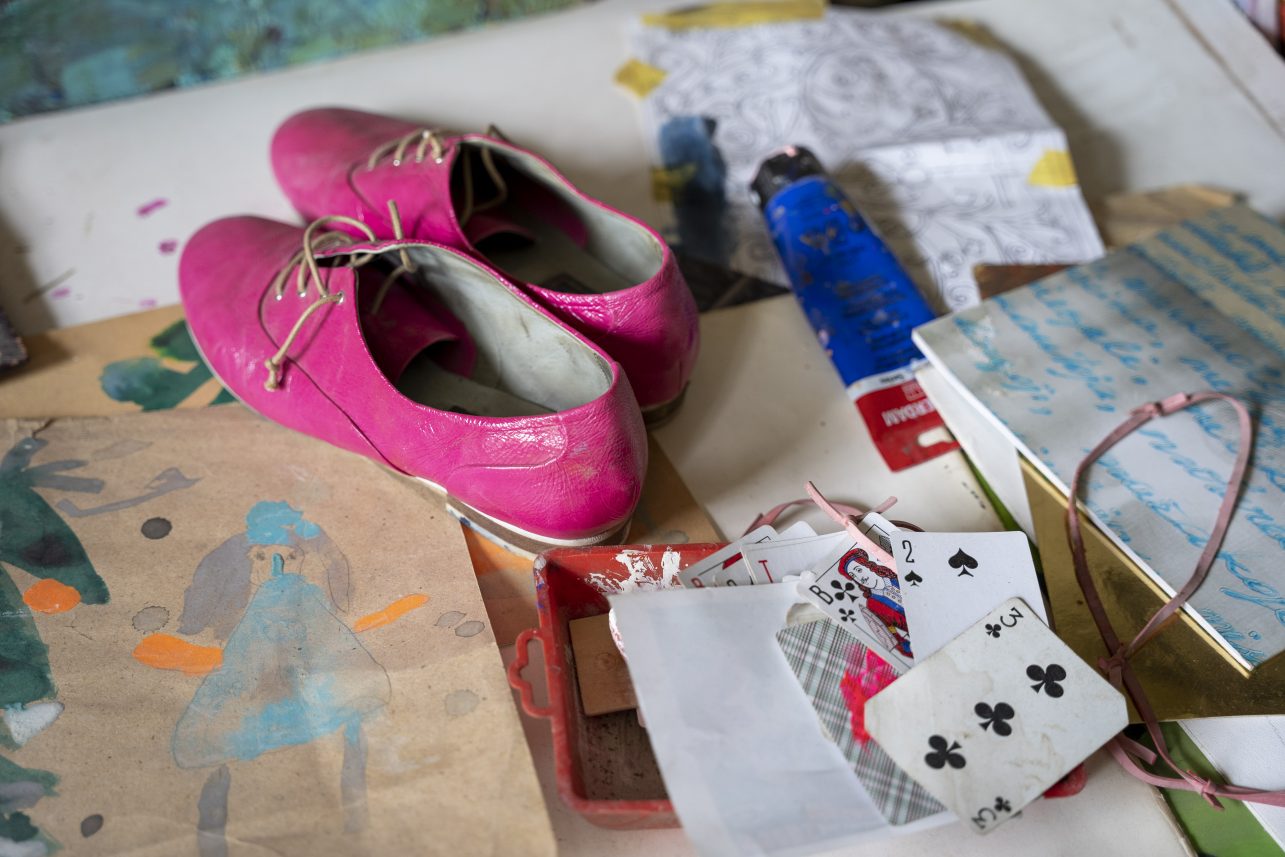
“These bright pink ones have worked a lot. I took them to the plein air and had the desire to paint them. During the opening, a man comes up and says, “I’d like to buy your shoes.” I was confused for a second, but then we realized that he wasn’t going to take them off my feet, he just wanted the painting,” Elena laughed and added, “I am convinced I will be painting them again. And look how beautiful are these pointy sandals. I imagine how their owner goes for a walk on Saturday night. A moderate but real sharp heel – aren’t they wonderful?”
I also recognize the yellow toy duck. It is painfully bright in the picture. “Oh, this one… The colour in the picture is an expression of the intrusiveness of the sound it emits. When I bought it, I put it on the fridge. My family members couldn’t take it and asked me to put it away. It is obnoxious and fun. You miss it and then get fed up quickly. Just like with people. Others have no taste at all. And he is an old friend of mine.”
For a moment, the hostess sobers down and gestures for me to sit down on the sofa.
“You can talk about colour in different ways, in different contexts, symbolically. Just like in music where there is both classical harmony and dissonance, the painting also has natural and synthetic colours, which express the glow of screens, all kinds of neon. You cannot distinguish colour from light, surface texture, and context. You cannot contemplate colour alone. Well, maybe verbally: ah, yellow. But it’s just phonetics. Light is a medium where colour spreads and changes, if you notice it everything becomes much more interesting. The Impressionists started playing with it.”
“Would you like me to show you a really ugly picture? Extremely annoying. That’s what I was aiming for,” says the artist and pulls out a large painfully pink picture covered with contrasting black spots.


“What is the story behind it?” I ask. “It was the topic: fake news. About information that spreads like a virus. It’s harmful like radiation, a toxic colour. The visual solution is borrowed from a small European firebug. Its poisonous smell is reflected by the colour. The insect pattern turns into a mask in the painting. An extremely irritating painting. Sometimes I can’t look at it anymore and I think I’m going to paint over it. Not everything has to last. As in life, you don’t know if an idea is good until you try it. And after testing it out, you can let go. Just imagining it does not cut it.”
A completely different painting is propped up next to it: a large, dark green one, probably unfinished, but if you look at it longer, you feel it sucking you in.
“Two colours, and you see the emotional impact of the green and that hysterical pink? This is a green plank. A place where everything can begin. Another important point in the effect of colour is its quantity. Why is green important to people? From nature, but why? I apply it on the canvas and observe how it affects me. I put it in front of me and tried to feel it. Another subtlety is how you apply the paint. The longer you look, the more you feel the pulsation. Or maybe this is how our heads work. Maybe we are longing for space and order, that’s why we want to be with this created emptiness. I had applied yellow before. But it wasn’t the right colour. Now it is good. I’m waiting to see what comes out of it. And maybe it will stay that way.”
“Actually, all of your works that I’ve seen have something going on. Someone or something keeps popping up – Ophelias, Kafkas, daffodils, movie stars,” I point out.
“I just have to involve a story. A landscape emerges, and a narrative is constructed within it. I have painted a series of art school drawing boards – one of them is currently exhibited in the Vilnius Town Hall – with a painted white square, like a sheet ready to be drawn on. I provoke the viewer; they really want to write or draw something there. The inspiration for this work came from this note that I kept seeing on the door of an institution that said, “Be back soon.” Do you see how philosophical it is? I am not here yet, but soon I will be,” Elena smiles.
“And do you choose colours rationally?” I ask.
“Sometimes rationally. Of course, things often change in a creative process. Colour is important from the very beginning, as a reflection of your state, it is the best starting point. Then I wonder why I need this today. What do I need a green board today for? You start by analyzing that green colour. There is the green of a billiard table, the green of an office table, and the green of a gambling table, and their shades and meanings are different. You could say that it is connected with nature – like peace and calming down. And what about the scary green colour of the school board? And when chalk appears on it… The experience of a student being invited to the blackboard (it can be green, ed.). It is related to experiences and states. Likewise, the drawing board of an art school, where you paint and draw, will not mean much to those who haven’t experienced it but will evoke strong feelings for others. After all, there are so many stories and associations.”
“The stories of your paintings usually don’t develop in an open space but as if on a flat surface, against the background of a wall. Often half-painted in perhaps not very pleasant but recognizable institutional green.”
“Yes. yes. The panel is not necessarily green. Supposedly, for practical reasons. They would paint up to a certain height with oil paint, and then above that with lime. For me, the wall in the background is a symbolic thing – I want to close the space – everything hits the plane, and the object is caught and pinned.”
“Are there ugly colours?”
“Of course. But everything is relative, so for a beautiful one to come through, there must be ugly ones next to it. Once I visited the late Jūratis Zalensas in his studio. He gifted me a wooden trough and said, “Look, we cleared out my mother’s workshop and there’s a whole bag of ugly-coloured paint. If you want it, you can take it. Maybe you need some, you use all kinds, anyway,” the artist remembered.
I asked, “So which ones are those ugly ones?”
“Dark green, brown, black – these kinds. But mostly dark green. Light cobalt green is beautiful, like viridian. So, Jūratis gave me a whole plastic bag of ugly colours.”
“They did not get lost, I hope?”
“Definitely not. I used them all. They are perfect for the colour of manure or pickles. How perfectly all kinds of transparent pinks and other ‘beautiful’ ones shine next to them. “Institutional green,” Elena laughs at my ‘invention’. “Colour names are very interesting. I have heard a discussion between A. Kuras and E. Cukermanas in an exhibition. They remembered the time they served in the military and tried to define the green colour of tanks. By the way, you don’t have to like the colours you use. They are a means of expression. I think it was Matisse, who said that you can create a need for colour, for example, by using cold blues, you start wanting a warm one. And there isn’t one. When the picture has a complete colour balance, it’s comforting. But maybe then there are no more questions, no issue. It isn’t interesting anymore.”
We decided to wander around the narrow streets of Šančiai, towards the Nemunas. And like Elena said, “You walk here and discover things whether you like it or not.” Emerald garage doors and window frames shine in brownish-monochrome grays, and installations of objects line up on windowsills just like in her paintings.


“Colour pops up here unexpectedly when a person needs a highlight. I like such unexpected combinations. When there is no polished design, everyone shapes the space in their own way. This is where the mysteries, urban poetry, and anecdotes of Šančiai develop.”
It is windy and unexpectedly bright along the Nemunas.
“The sun is low in autumn, like a stage light. And when it appears, it flashes. That light – just like when a person smiles – is like unexpectedly white teeth. Those American porcelain ones,” Elena laughs.
“Does life get mode depressive when it gets darker, as the winter approaches?”
“No. It doesn’t get happier, but I don’t feel sad either. It all depends on what you do, and how you immerse yourself in things. Summer joy is more dissonant to me, sometimes I can’t keep up with it. Pop out of the house like a potato sprout from the basement. But things get better when I catch up to summer. I like the end of August and the beginning of September the most. And this year was a gift. And now again – how beautiful everything is. I have been coming here for twenty years. It’s fun with Leila by the river. I unleash her and she gallops like a horse: wonderful. Crows, Napoleon’s hat – it’s good here even in winter. I come at a time of day when there are no people. The dog runs into the water to scare the ducks. It’s so much fun!
Freedom. The blue-gloved Virginia Woolf would think and smile to herself back at the studio.


